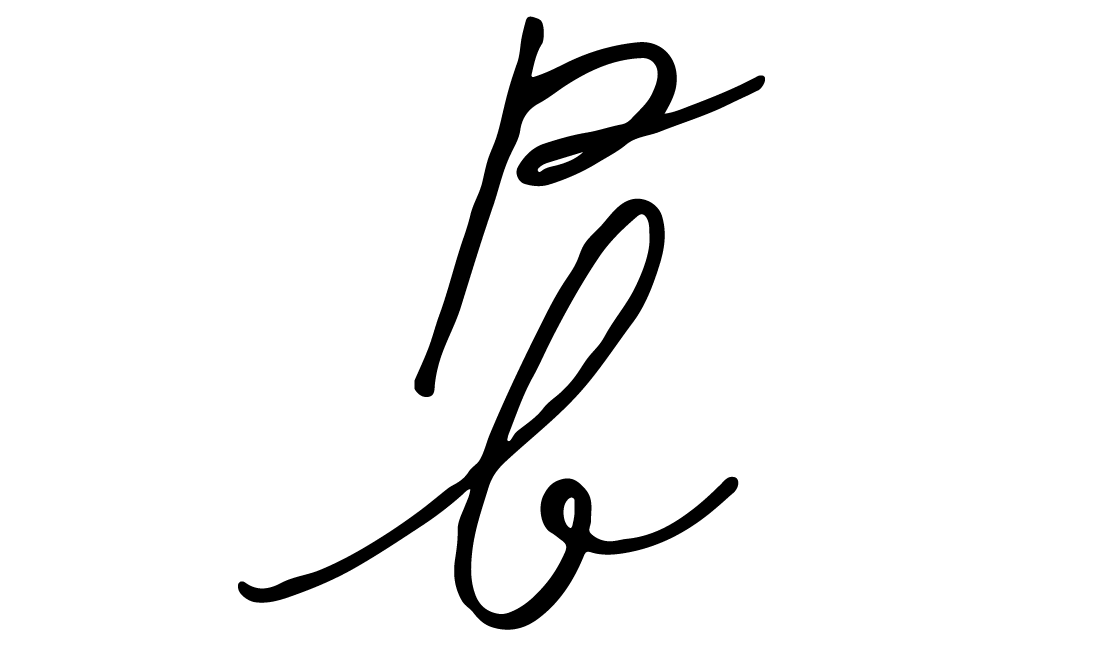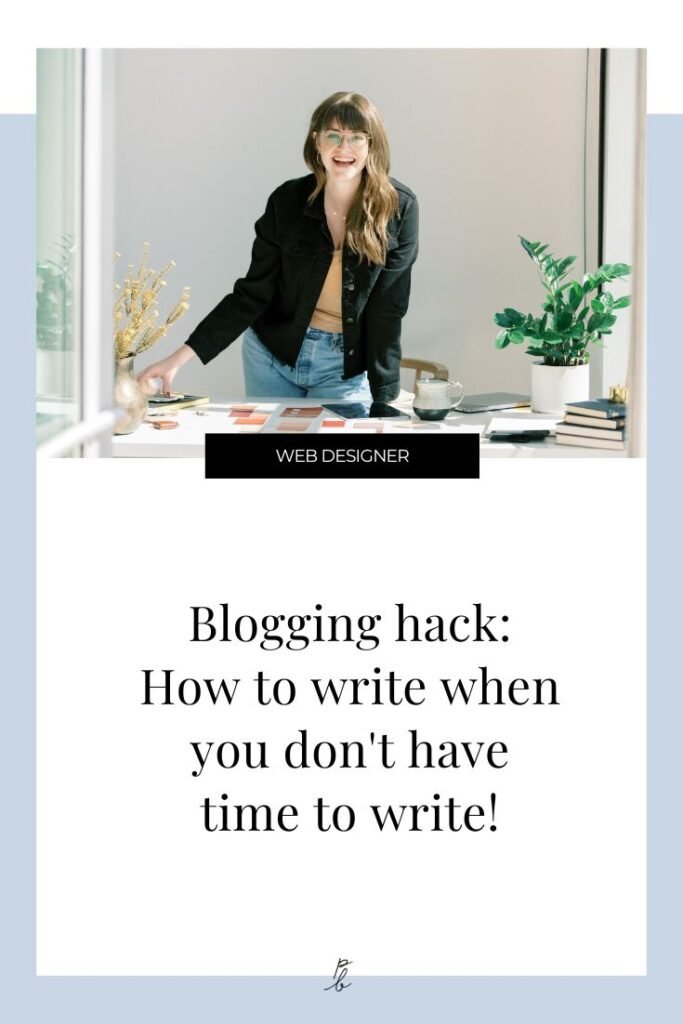Blogging hack: How to write when you don't have time to write!
Meet Emily! 👋
(Insanely-talented past student and actual web designer goddess behind Emily Agan Studio!) 🤌
Some of you may remember this lovely face from when she generously shared all her best tips for balancing business when you've got a new baby on the other hip! (If you're a momma or soon-to-be momma, and you haven't checked out that post, it's definitely worth the read!
This time, she's sharing how she manages to stay consistent with content creation EVEN when she's crazy short on time!
Her advice is both practical and encouraging and just generally gold!
So without further ado...
BLOGGING HACK: HOW TO WRITE WHEN YOU DON'T HAVE TIME TO WRITE!
Raise your hand if you're busy AF and don't have time to write 🙋🏻♀️
Honestly, I can't imagine any business owner saying, "I just love writing and have ample time to sit and craft my content every single day."
Most of us are barely hanging on by a thread, and it's a real struggle to blog, write Instagram captions, email threads, and even content for other businesses. It's some serious creative work, and it feels so daunting to carve out the mental space to make it happen.
But do it we must - because writing is the hook to draw in our desired audience, who will (fingers crossed 🤞🏻) eat up our every word and buy our products and services.
So... how do we write when we don't have time to write?!
My efficient writing hacks have made it possible for me to bust out content while still running a full-time business, raising a toddler, and enjoying my weekends (work free). And with a little effort, you'll be able to produce swift chunks of content in a breeze, too.
Prep
To start...
1. Create a Copywriting Folder
Keep a folder of ideas, and you'll never be stuck in the pits of writing despair again. I personally like to use ClickUp for all of my ideas. It's my go-to project management system, but you could just as easily do this in Google Folders, Google Keep, Asana, Notion... or a chisel and tablet if that's your thing.
Just be sure that it's easy to access. The whole point is to save on time - it's not very speedy to dig through endless tabs of information while you're flipping pancakes at 2:00 am... I have weird work hours.
Do some prep work on the front end with your organization too. Sure, you can easily drop every idea known to man into a big box of "I'll reference this later," but then never touch it because it makes you want to cry.
The solution is to create subfolders labeled as:
Titles Ideas/Subject Lines
Story Starters
Content Ideas
Keywords
With my current workload, I barely have time to complete my client work, let alone research amazing blog post ideas. I'm guessing you're in the same boat since you're reading this post, so you may be wondering, "Okay, great, got my folders... now what?"
Now you integrate your collection into your daily life and work. Here's what I mean.
Collect ideas any time you get a question from a client via email, Instagram, Facebook, text, or in my case, a lot of the time... Loom videos.
Collect ideas when you have 1-on-1 conversations with clients... you usually take notes anyway, right? If not, that's okay - #nojudgement, just keep those folders handy and nearby.
Collect ideas from conversations with friends and family when chatting about your job. BRB, that would make a great headline! 🏃🏻♀️💨
Now you might be thinking... "Uh, Emily - rude. I'm supposed to be intentional with all of these interactions, not glued to my phone/laptop taking notes."
Okay, first of all, making a one-liner note is going to take all of 2 seconds to write (with my techniques, of course). Secondly, the idea muse, a.k.a. your client, mom, or the grocery store check-out lady, will more than likely be flattered that they sparked such a brilliant idea.... no hard feelings will be had.
So... the real question is. How do we save these ideas in an easy way that doesn't disrupt our work or busy, busy life?
2. Saving Content Ideas
Accessible Folders
First up, you need to make your folders as easy to access as possible.
If you're using a Project Management System, there's a high probability you have access to an app, browser extension, or even Gmail integration. So do a little digging and get these bad boys set up and ready to sweat.
With ClickUp I use the mobile app plus the Chrome extension to collect my ideas. If you're using something like Google keep or Google anything, I would recommend getting an extension, too, so you can access it in just one click.
Efficient Saves
Next, we want to funnel the ideas into your folders in as few steps as possible.
If you're on a laptop, save time by copying and pasting the text directly into your folder - OR even faster - screenshot (see below for the keyboard shortcut) and paste an image of the text.
If you're on your phone, use voice commands to quickly access your note-taking app, "Hey Siri" and then voice type the note and save it for later.
Over time, you'll have a boatload of ideas to choose from when it comes time to actually write your content.
Tips for Writing
1. Write From Your Brain First
First, write everything YOU KNOW on the subject before doing research - it's faster. You're just extracting information from your own brain. If you start to Google, it's a slippery time-sucking slope that's hard to get out of - save stat checking for the very end.
2. Voice Typing
The average typing speed is 40 words per minute. The average talking speed is 150 words per minute. I think you can see why this is a valuable tool. I like to use voice typing for my outlines and brain dumps, but if it suits, you could just as well write the whole piece of content this way.
Plus, talking to text makes writing with a conversational tone way easier - and it allows you "more time" because you can easily chat on the go. Work on your piece of content while on a walk, doing laundry, or even at the grocery store (if you're not easily embarrassed.) This is multitasking at its finest, so just know that if you're not great at first, you will get better.
3. Focused Writing Session
If you're gonna sit down and crank out some serious writing, then prep for the occasion. Make yourself unavailable - phone off, use the bathroom, get a snack (I can't tell you how many times I've had to stop writing because of low blood sugar - be prepared), refill your coffee, disconnect from Wi-Fi, put on some music or brown noise. Eliminate all distractions.
Pro-tip: Write from your car. Not while driving, of course, but parked in a safe area. It's one of the best distraction-free, focused writing spaces I have ever found - and I personally get a lot done when I write there.
4. Start With The Easiest Part
The last thing you want to do is try to write in order - coming up with the intro is one of the hardest parts, so just go ahead and skip that. Pick a section of the piece that is a no-brainer for you. It's like a warm-up, once the words start flowing, it'll be easier to slide, like Risky Business Tom, into other sections.
5. Write At The "Right" Time Of Day
For me, this is first thing in the morning, before my family is awake and before my official business hours. But the focused hour is different for everyone.
Honestly, you need to test this for yourself and find out what really works. You might think it’s whenever you’re most alert, but that’s not always true. You might actually write better when you're less with it because your inhibitions are down - when you're too tired to care if something sounds good and your inner critic is out cold.
6. Silence Your Inner Critic
Brain dump and DO NOT EDIT.
Tips to help:
The first draft is supposed to be bad. So write something terrible - this mindset shift will take off the pressure.
If you can't think of the perfect phrase or word, just make a note and move on (xxxx or a really amazing story goes here).
Tell yourself that you can continue to edit the post even after it's published and re-publish it even better than it was before (even if you don't follow through on this promise - perfectionism is a time killer.
7. Crank Up The Pressure
Use the Pomodoro Technique (25-minute chunks separated by five-minute breaks) and make some serious goals for each session
Example:
Round 1: Outline & shitty first draft
Round 2: Edit, edit, edit
Round 3: Collect photos, links, research stats, etc.
Round 4: Upload, settings, and set to publish
Do it all on one day or spread it out over a week - but SET A DEADLINE.
8. Keyboard Shortcuts
I'm not gonna lie... this can feel clunky at first if you're not used to using keyboard shortcuts. But once these babies get embedded in your brain, you'll wonder how you ever lived without them.
They seriously save so much time - or it feels like it, anyway.
Editing
1. Change Up When and Where You Edit
I find that it's best to put these sessions on separate days. When you have a good night's sleep or a change of venue, you'll have more clarity on what you previously wrote.
2. Use A Typing Assistant Like Grammarly
I use this app for all of my writing. It's a typing assistant that reviews spelling, grammar, punctuation, and mistakes - but it's extra awesome because you can set the tone of writing that you're going for. So if your audience is more casual, you won't be flagged for every, “OMG” and “gurl” that you write.
Get the extension, and it will also appear in other apps. I like to write directly into ClickUp - and Grammarly integrates directly with the platform.
3. Get Vocal
Read it out loud, and you'll get an immediate sense of how it 'should' feel; the way the words fit together and work as a whole - like a piece of music. You'll notice what's weird faster - making editing faster.
4. Revise, Revise, Revise
Once you've done all this, go through your content over and over until it sounds "good enough."
Remember, we're aiming for speed, not perfection - we're our own worst critics, and sticking with this "do it messy" mentality will help get the piece published rather than sitting in your drafts for months on end.
Final Thoughts
Writing faster is like running faster. The more you train, the more your muscles grow, and the faster you get. Writing with all of these efficiency hacks WILL be clunky at first, and that's okay. The key is to stick with it. Soon you'll be a speed writing superhuman, and your audience will wonder, "How the heck do they have time to write so much?!"
You've got this, friend!





